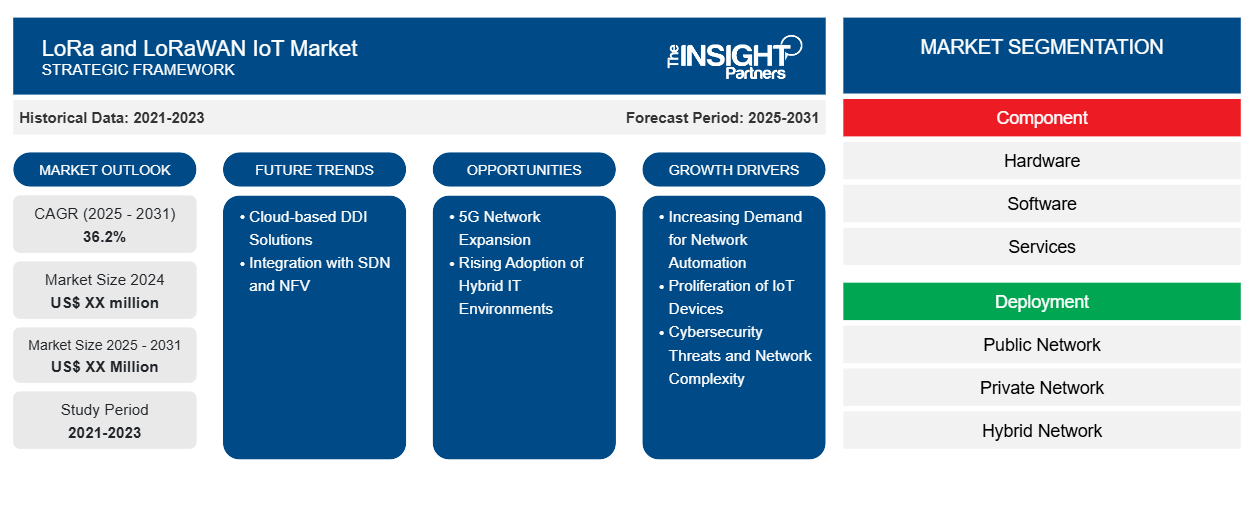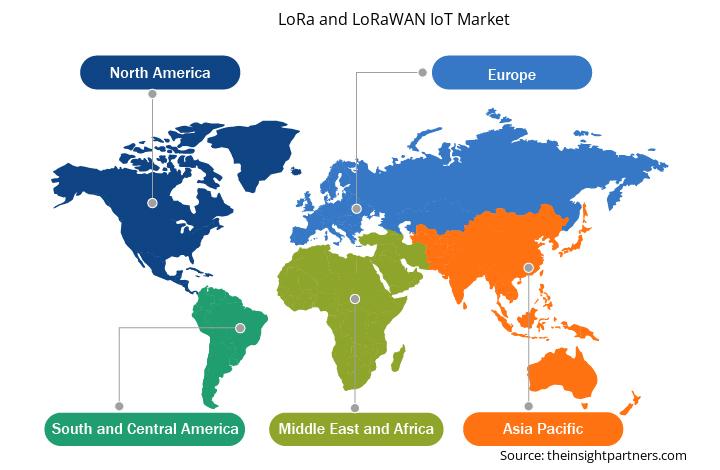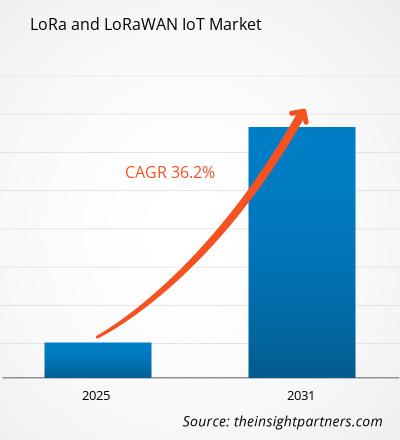预计 LoRa 和 LoRaWAN 物联网市场在 2025 年至 2031 年期间的复合年增长率为 36.2%,市场规模将从 2024 年的 XX 百万美元扩大到 2031 年的 XX 百万美元。
报告按组件(硬件、软件、服务)细分;部署(公共网络、专用网络、混合网络);组织规模(大型企业、中小企业);最终用户(制造业、运输和物流、能源和公用事业、政府和公共安全、医疗保健、零售等)。全球分析进一步细分为区域和主要国家。报告以美元为单位提供上述分析和细分的价值
报告目的
Insight Partners 发布的《LoRa 和 LoRaWAN 物联网市场》报告旨在描述当前形势和未来增长、主要驱动因素、挑战和机遇。这将为各种业务利益相关者提供见解,例如:
- 技术提供商/制造商:了解不断变化的市场动态并了解潜在的增长机会,从而能够做出明智的战略决策。
- 投资者:对市场增长率、市场财务预测以及整个价值链中存在的机会进行全面的趋势分析。
- 监管机构:监管市场政策和警察活动,旨在最大限度地减少滥用行为,维护投资者的信任和信心,维护市场的完整性和稳定性。
LoRa 和 LoRaWAN 物联网市场细分
成分
- 硬件
- 软件
- 服务
部署
- 公共网络
- 专用网络
- 混合网络
组织规模
- 大型企业
- 中小企业
最终用户
- 制造业
- 运输与物流
- 能源与公用事业
- 政府与公共安全
- 卫生保健
- 零售
定制此报告以满足您的需求
您可以免费定制任何报告,包括本报告的部分内容、国家级分析、Excel 数据包,以及为初创企业和大学提供优惠和折扣
LoRa 和 LoRaWAN 物联网市场:战略洞察

- 获取此报告的关键市场趋势。这个免费样品将包括数据分析,从市场趋势到估计和预测。
LoRa 和 LoRaWAN 物联网市场增长动力
- 网络自动化需求不断增长:随着业务扩展和 IT 基础设施复杂性的增加,对网络自动化解决方案的需求也不断增长。DDI(DNS、DHCP 和 IP 地址管理)解决方案可实现网络操作自动化,提高运营效率,减少人工错误并实现可扩展性。对管理动态 IP 地址环境的自动化需求不断增长,直接推动了 DDI 市场的增长。
- 物联网设备激增:物联网 (IoT) 推动的联网设备快速增长,极大地扩大了对高效 IP 地址管理的需求。DDI 解决方案有助于管理大量 IP 地址,通过自动化 IP 分配和确保网络可扩展性来提供实时数据并最大限度地减少停机时间,从而推动 DDI 市场增长。
- . 网络安全威胁和网络复杂性:随着网络安全威胁的增加和网络的日益复杂,企业需要强大的 DNS、DHCP 和 IP 地址管理解决方案来实现更好的控制、可视性和安全性。DDI 解决方案增强了网络弹性,确保防范 DDoS 攻击、DNS 欺骗和其他漏洞,这是市场的主要驱动力。
LoRa 和 LoRaWAN 物联网市场未来趋势
- 基于云的 DDI 解决方案:云的采用在各个行业中迅速增长,导致对基于云的 DDI 解决方案的偏好日益增加。这些解决方案提供灵活性、成本效益和可扩展性,使企业能够跨多个环境管理网络基础设施。向基于云的服务的转变是推动 DDI 市场扩张的重要趋势。
- 与 SDN 和 NFV 集成:DDI 解决方案与软件定义网络 (SDN) 和网络功能虚拟化 (NFV) 的集成正在改变网络管理方式。这一趋势实现了网络服务的动态和自动化配置,创建了更敏捷、更灵活、更安全的基础设施,进一步加速了 DDI 技术的采用。
LoRa 和 LoRaWAN 物联网市场机会
- 5G 网络扩展:5G 网络的推出为 DDI 解决方案带来了重大机遇。5G 有望大幅增加联网设备和用户的数量,从而需要更复杂的 IP 地址管理。DDI 供应商可以利用这种对增强地址分配和管理日益增长的需求,从而增加市场机会。
- 混合 IT 环境的采用率不断提高:随着组织转向结合本地和云基础设施的混合 IT 环境,他们需要高效的 DDI 解决方案来无缝管理不同的网络环境。混合环境的采用率不断提高,为 DDI 供应商提供了提供全面解决方案以有效管理这些复杂网络的机会。
LoRa 和 LoRaWAN 物联网市场区域洞察
Insight Partners 的分析师已详细解释了预测期内影响 LoRa 和 LoRaWAN 物联网市场的区域趋势和因素。本节还讨论了北美、欧洲、亚太地区、中东和非洲以及南美和中美洲的 LoRa 和 LoRaWAN 物联网市场细分和地理位置。

- 获取 LoRa 和 LoRaWAN 物联网市场的区域特定数据
LoRa 和 LoRaWAN 物联网市场报告范围
| 报告属性 | 细节 |
|---|---|
| 2024 年的市场规模 | XX 百万美元 |
| 2031 年市场规模 | XX 百万美元 |
| 全球复合年增长率(2025 - 2031) | 36.2% |
| 史料 | 2021-2023 |
| 预测期 | 2025-2031 |
| 涵盖的领域 | 按组件
|
| 覆盖地区和国家 | 北美
|
| 市场领导者和主要公司简介 |
|
LoRa 和 LoRaWAN 物联网市场参与者密度:了解其对业务动态的影响
由于消费者偏好的不断变化、技术进步以及对产品优势的认识不断提高等因素,最终用户需求不断增加,推动了 LoRa 和 LoRaWAN 物联网市场快速增长。随着需求的增加,企业正在扩大其产品范围,进行创新以满足消费者需求,并利用新兴趋势,从而进一步推动市场增长。
市场参与者密度是指在特定市场或行业内运营的企业或公司的分布情况。它表明在给定市场空间中,相对于其规模或总市场价值,有多少竞争对手(市场参与者)存在。
在 LoRa 和 LoRaWAN 物联网市场运营的主要公司有:
- 博世集团
- 思科
- 奥兰治南非公司
- 康卡斯特公司
- 升特
- 日本电气公司
免责声明:上面列出的公司没有按照任何特定顺序排列。

- 获取 LoRa 和 LoRaWAN 物联网市场顶级关键参与者概览
主要卖点
- 全面覆盖:报告全面涵盖了LoRa和LoRaWAN物联网市场的产品、服务、类型和最终用户的分析,提供了整体概况。
- 专家分析:报告基于对行业专家和分析师的深入了解而编写。
- 最新信息:该报告涵盖了最新信息和数据趋势,确保了其与业务的相关性。
- 定制选项:此报告可以定制以满足特定客户要求并恰当地适应业务策略。
因此,LoRa 和 LoRaWAN 物联网市场研究报告有助于引领解读和了解行业情景和增长前景。尽管可能存在一些合理的担忧,但本报告的总体优势往往大于劣势。
- 历史分析(2 年)、基准年、预测(7 年)及复合年增长率
- PEST和SWOT分析
- 市场规模、价值/数量 - 全球、区域、国家
- 行业和竞争格局
- Excel 数据集
近期报告
客户评价
购买理由
- 明智的决策
- 了解市场动态
- 竞争分析
- 客户洞察
- 市场预测
- 风险规避
- 战略规划
- 投资论证
- 识别新兴市场
- 优化营销策略
- 提升运营效率
- 顺应监管趋势




















 获取免费样品 - LoRa和LoRaWAN物联网市场
获取免费样品 - LoRa和LoRaWAN物联网市场